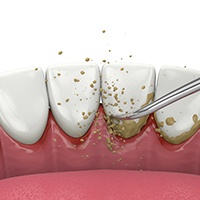Periodontal Treatment in Carlisle
 Periodontal (gum) disease is one of the most common oral health concerns in the US. Some estimates place the number of gum disease suffers at more than 70% of the adults over 30, and it is the leading cause of tooth loss for these adults. This oral health issue begins with mild discomfort that may go unnoticed. As plaque and tartar buildup at the gum line, soft tissue is irritated. Left untreated, this irritation leads inflammation and infection breaking down gum tissue that connects teeth and preserves facial shape. At Flenniken Family Dentistry, we have a dedicated Periodontist on staff — Marvin Berger, DDS — allowing us to better serve our patients with advanced non-surgical and surgical periodontal treatments.
Periodontal (gum) disease is one of the most common oral health concerns in the US. Some estimates place the number of gum disease suffers at more than 70% of the adults over 30, and it is the leading cause of tooth loss for these adults. This oral health issue begins with mild discomfort that may go unnoticed. As plaque and tartar buildup at the gum line, soft tissue is irritated. Left untreated, this irritation leads inflammation and infection breaking down gum tissue that connects teeth and preserves facial shape. At Flenniken Family Dentistry, we have a dedicated Periodontist on staff — Marvin Berger, DDS — allowing us to better serve our patients with advanced non-surgical and surgical periodontal treatments.
What are Symptoms of Gum Disease?
- Red or purplish gums that are swollen or sensitive
- Bleeding while brushing and flossing
- Receding gum line causing teeth to appear longer
- Teeth that feel loose or new or wider spaces between teeth
- Persistent bad breath that does not improve after cleaning
- Bad taste in the mouth
If you recognize one or more of these symptoms, contact Dr. Neil Flenniken and Dr. Suzan Rismani-Flenniken right away. Diagnosing and treating the disease in its earliest stages allows us to undo the damage of periodontal disease restoring oral health with more frequent professional cleanings. We also provide more advanced surgical and non-surgical treatments for more advanced conditions.
Scaling & Root Planing

Gum disease can result in receding gumlines that jeopardize the stability of your teeth so it’s important to address it as soon as possible. If you’re wondering how this infection is treated, you’re not alone! Many patients wonder how their dentist can help them overcome this pervasive problem. Typically, the most common treatment recommendation is a combination of scaling and root planing. This allows our team to remove harmful bacteria and prevent a recurrence to preserve your oral health. If you’d like to know more about what’s involved in this procedure, continue reading below, or feel free to contact us with additional questions.
Do I Need Scaling & Root Planing?

Although it’s an effective way to treat gum disease, scaling and root planing may not be the right answer for everyone. In its earliest stages, the problem might be more effectively managed by establishing a consistent at-home oral hygiene routine.
However, once your gum disease has progressed to a certain point then scaling and root planing may be recommended. You might require this remedy if you notice symptoms like:
- Visible plaque buildup
- Bleeding gums when you brush or floss
- Receding gumline
- Chronic bad breath
- Persistent foul taste in your mouth
- Shifting teeth
- Difficulty Chewing
The Process of Scaling & Root Planing

You can generally anticipate that the entire process from start to finish will take place throughout two separate appointments. The different stages are:
- Scaling: Our team will use specially designed instruments to scrape away plaque and tartar from your teeth and gumline. Then, we’ll clear away any buildup that may have penetrated below your gums in the gingival pockets.
- Root Planing: Next, we’ll smooth out the sections of your teeth that are normally hidden below your gums. This helps them reattach and discourages additional future buildup.
Aftercare Tips for Scaling & Root Planing

Many patients experience some slightly tender or bleeding gums and mild tooth sensitivity for a few days after their procedure. To prevent infection, it’s important to care for your smile correctly. Some helpful tips include:
- Rinse with warm salt water. Add ¼ teaspoon of salt into 8 oz. of warm water and stir until it’s dissolved. Then gently sip and swish it around your mouth before spitting it out. Feel free to continue rinsing until your glass is empty.
- Brush gently. To avoid irritating your sore gums, use a soft-bristled brush and circular motions to gently scrub your teeth.
- Watch what you eat. Stick to soft foods for the first 48 hours to give your mouth a break. After that, it’s a good idea to steer clear of overly hot and spicy foods, as well as acidic drinks or alcohol, that can exacerbate inflammation.
- Rest up. Try not to engage in physical activities that elevate your heart rate because this can prolong the healing process.
Non-Surgical Periodontal Procedures
Root Planing and Scaling
The most common treatment recommendation for patients with moderately advanced gum disease is a combination of scaling and root planing. Scaling is the removal of plaque and tartar below the gum line, and root planing is the smoothing out of the surface of tooth roots to prevent future re-infection stimulating faster healing. At Flenniken Family Dentistry, our team uses local antibiotic treatments to preserve gum health and prevent further bacterial build up. These treatments in addition to thorough at home care allow patients to maintain their restored oral health.
Periodontal Maintenance Therapy
Patients who suffer from advanced periodontal disease experience significant relief following scaling and root planing, but they are always at an elevated risk for re-occurrence. For this reason, our team takes time to create a personalized follow up maintenance plan to preserve oral health. This will likely include more frequent cleanings at our practice three to four times each year.
What Surgical Procedures Do You Offer?
Pocket Depth Reduction
One of the main side effects of advanced periodontal disease is the breakdown of gum tissue creating deeper pockets between the teeth and gums. Left untreated, this deterioration of gum tissue leads to tooth loss and other concerns. Pocket reduction therapy occurs following the removal of damaged or infected gum and bone tissue followed by the reattachment of tissue to the bone leading to quick, pain-free healing and regeneration of lost tissue.
Regeneration & Bone Grafting
The Flenniken Family Dentistry team is skilled in offering bone grafting and regeneration services when jawbone density is diminished following periodontal disease.
Soft Tissue Grafting
For patients who have significant loss of gum tissue following periodontal disease, we may need to replace the tissue in order to restore oral health. Soft tissue grafting procedures allow our team to use healthy tissue from other parts of the mouth to replace damaged gum tissue and aid in the regenerative process.
Osseous Surgery
One serious defect that occurs due to advanced periodontal disease, periodontitis, is the loss of supportive bone tissue. The Alveolar bone provides support for teeth, and holes and defects caused by periodontitis weaken this supportive bone structure. Osseous surgery restores the full structure by reshaping or replaces lost bone tissue. Dr. Neil Flenniken and Dr. Suzan Rismani-Flenniken are both skilled in offering osseous surgery to fully renew and complete smiles after even the most severe dental damage.












